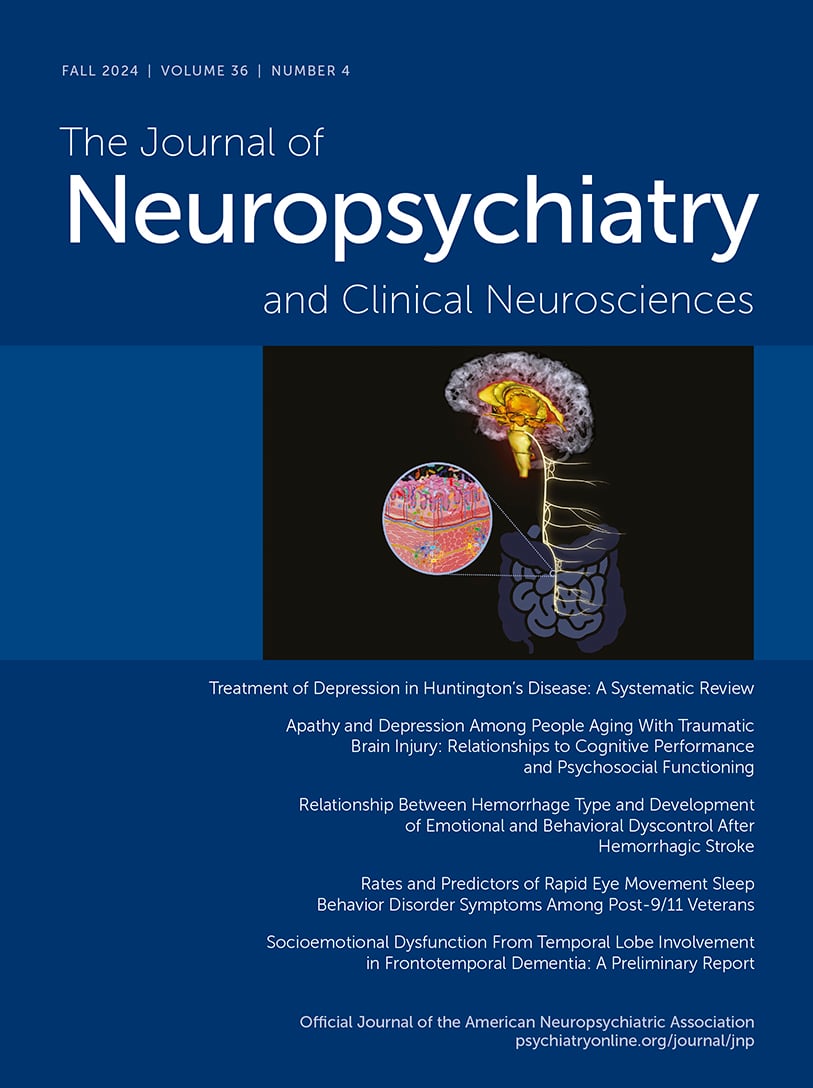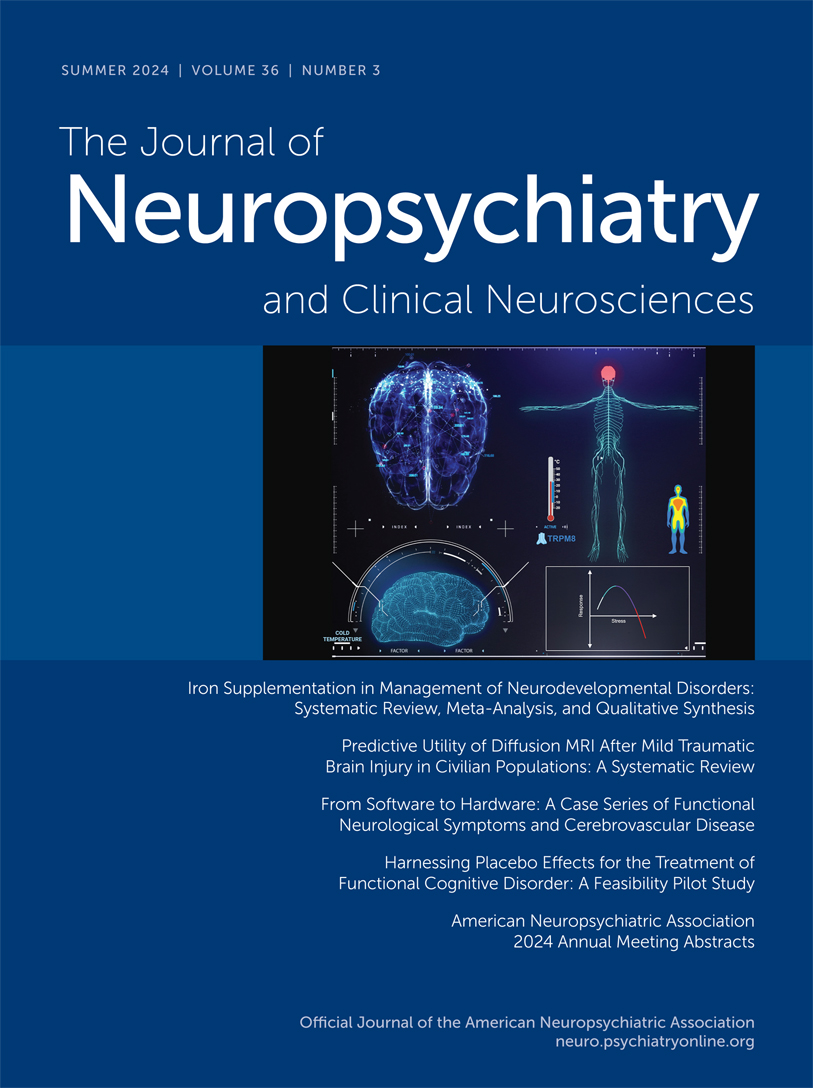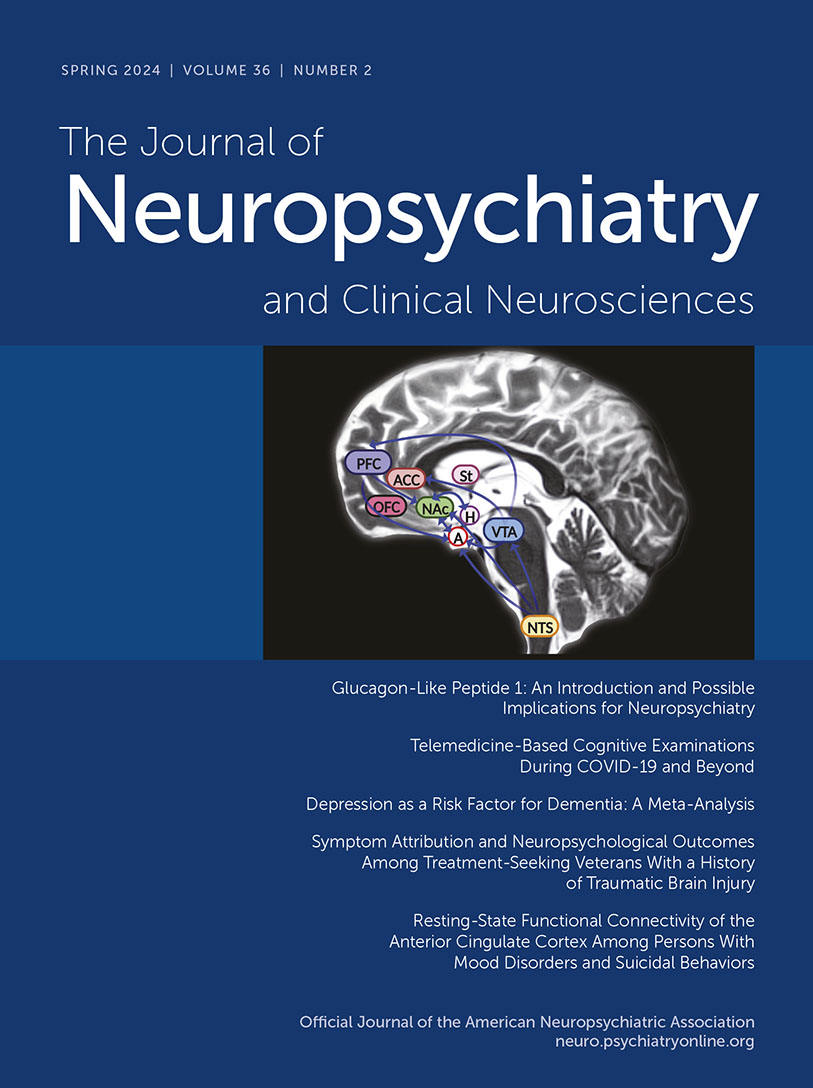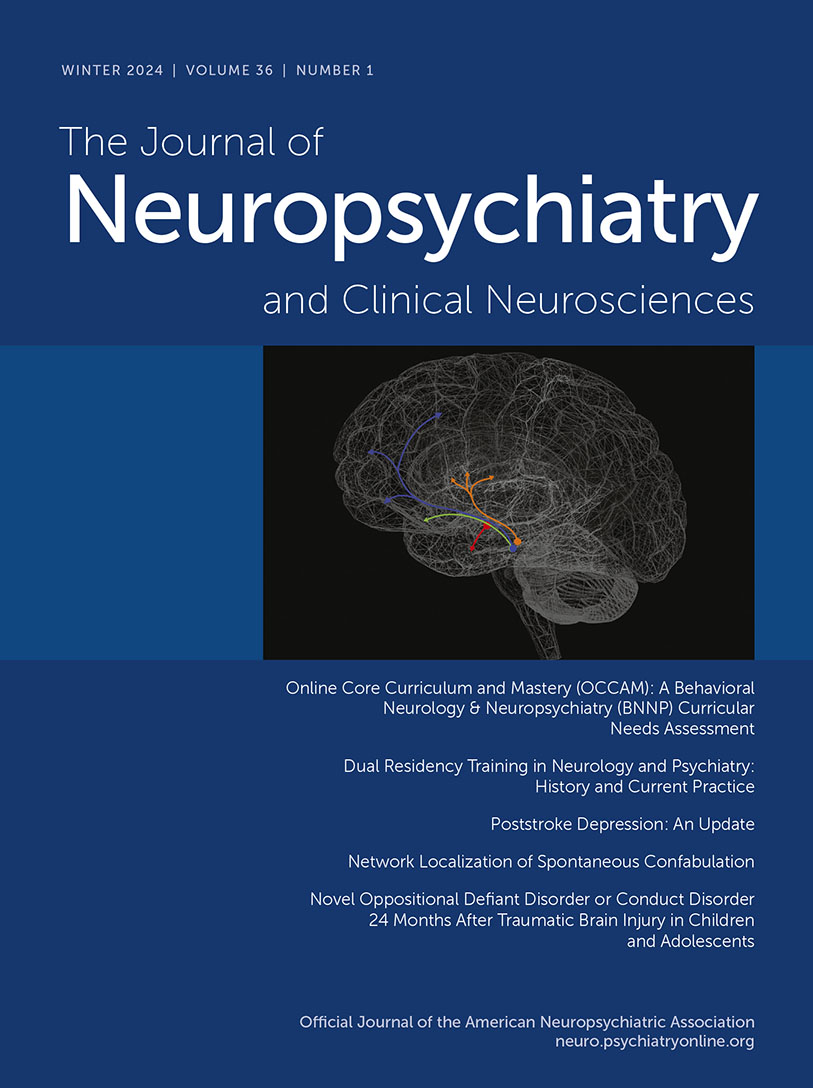The Journal of Neuropsychiatry and Clinical Neurosciences
- Volume 27
- Number 4
- October 2015
Windows to the Brain
Features
Special Articles
Publication date: 12 June 2015
Pages254–261Schizophrenia is characterized by profound deficits in social competence and functioning, independent from active psychotic symptoms at different stages of the disease. Social deficits in schizophrenia are clinically well characterized, but their ...
https://doi.org/10.1176/appi.neuropsych.14120377Publication date: 24 March 2015
Pages262–271Anxiety is common in Huntington’s disease (HD), though it has been under-researched. The authors conducted a systematic review of anxiety in HD. The prevalence of anxiety in manifest HD ranged from 13% to 71%. No significant difference in anxiety between ...
https://doi.org/10.1176/appi.neuropsych.14100265Features
Regular Articles
Publication date: 17 July 2015
Pages272–279Personality change due to traumatic brain injury (PC) in children is an important psychiatric complication of injury and is a form of severe affective dysregulation. This study aimed to examine neurocognitive correlates of PC. The sample included 177 ...
https://doi.org/10.1176/appi.neuropsych.15030073Publication date: 10 August 2015
Pages280–286This study aimed to characterize preinjury emotional-behavioral functioning in pediatric patients with lingering problems after mild traumatic brain injury (TBI). The clinical case series design included 278 patients 8–17 years old. Parents ...
https://doi.org/10.1176/appi.neuropsych.14120373Publication date: 24 March 2015
Pages287–298Diagnostic methods are considered a major concern in the determination of mild traumatic brain injury. The authors examined brain oxygenation patterns in subjects with severe and minor persistent postconcussive difficulties and a healthy control group ...
https://doi.org/10.1176/appi.neuropsych.14100276Publication date: 10 August 2015
Pages299–303There are limited data regarding the incidence of pathological laughter and crying (PLC) after traumatic brain injury (TBI). This study aimed to identify the occurrence of PLC in the first year after TBI and to determine whether there is a relationship ...
https://doi.org/10.1176/appi.neuropsych.15030045Publication date: 10 August 2015
Pages304–310The authors assessed how family history loading affected the course of illness in patients from the United States. A total of 676 outpatients with bipolar disorder from the United States rated their illness and provided a parental and grandparental ...
https://doi.org/10.1176/appi.neuropsych.14080204Publication date: 06 February 2015
Pages311–321Pre-ECT neurology consultations are often requested to determine the relative risk of the procedure in patients with neurological comorbidities, but there is limited data to guide clinicians. The authors performed a retrospective chart review of all ...
https://doi.org/10.1176/appi.neuropsych.14080195Publication date: 24 March 2015
Pages322–325The authors compared the risk for subjective cognitive impairment (SCI) between carriers of the apolipoprotein E ε4 (APOE ε4) allele (cases) and APOE ε4 noncarriers (controls). SCI was assessed by a validated self-reported questionnaire. The authors used ...
https://doi.org/10.1176/appi.neuropsych.14100268Publication date: 01 October 2015
Pages326–332A cross-sectional analysis examined medication records in the National Alzheimer’s Coordinating Center Database for community-dwelling patients with dementia who visited an Alzheimer’s Disease Center between 2008 and 2014. Hispanic participants had a 1.62-...
https://doi.org/10.1176/appi.neuropsych.15010020Publication date: 17 July 2015
Pages333–338To better understand the natural history of poststroke apathy, the authors tested 96 patients undergoing acute rehabilitation for stroke using the Apathy Inventory. A total of 28% of patients had apathy. Their Apathy Inventory scores improved a mean of 1 ...
https://doi.org/10.1176/appi.neuropsych.15010001Publication date: 17 July 2015
Pages339–344Epilepsy affects not only the patient but also the patient’s cohabiting relatives, to various degrees. This study investigated state and trait anxiety, depression, and social fear and avoidance levels in 48 adult patients with epilepsy and 48 family ...
https://doi.org/10.1176/appi.neuropsych.15030061Publication date: 17 July 2015
Pages345–353Intolerance of uncertainty is a key contributor to anxiety-related disorders. Recent studies highlight its importance in other clinical disorders. The link between its clinical presentation and the underlying neural correlates remains unclear. This review ...
https://doi.org/10.1176/appi.neuropsych.14120387Publication date: 10 August 2015
Pages354–361The authors examined current research trends in neuropsychiatry by analyzing original research studies published since the new millennium. A total of 14,587 articles published between 2000 and 2013 were systematically screened from 10 neuropsychiatry ...
https://doi.org/10.1176/appi.neuropsych.15010024Features
Clinical and Research Reports
Publication date: 06 February 2015
Pages362–364In contrast to improvement in emotion recognition bias by traditional antidepressants, the authors report preliminary findings that changes in facial emotion recognition are not associated with response of depressive symptoms after repeated ketamine ...
https://doi.org/10.1176/appi.neuropsych.14100243Publication date: 24 March 2015
Pages365–370Patients with delirium may fail to respond to standard therapies. Sixteen patients with management-refractory hyperactive delirium responded to adjunctive valproic acid, with complete resolution of hyperactive delirium in 13 cases. A rationale for using ...
https://doi.org/10.1176/appi.neuropsych.14080190Departments
In Appreciation
Departments
Correction
Past Issues
View Issues Archive
Vol. 36 | No. 4

Vol. 36 | No. 3

Vol. 36 | No. 2
